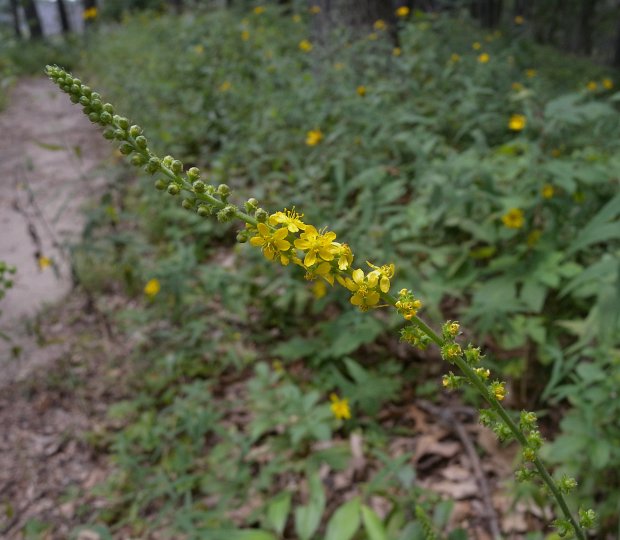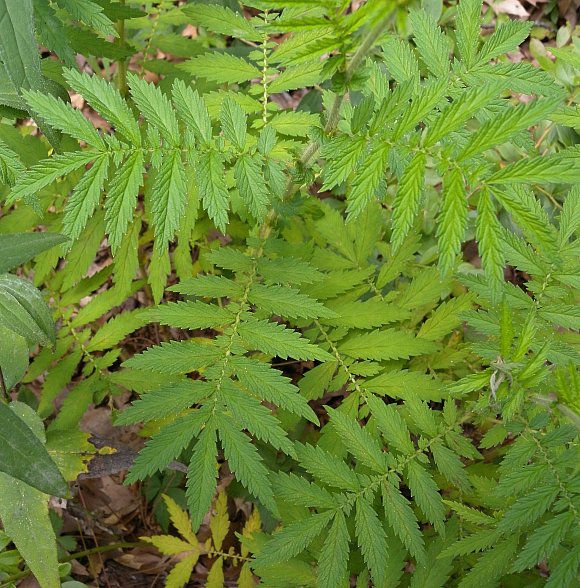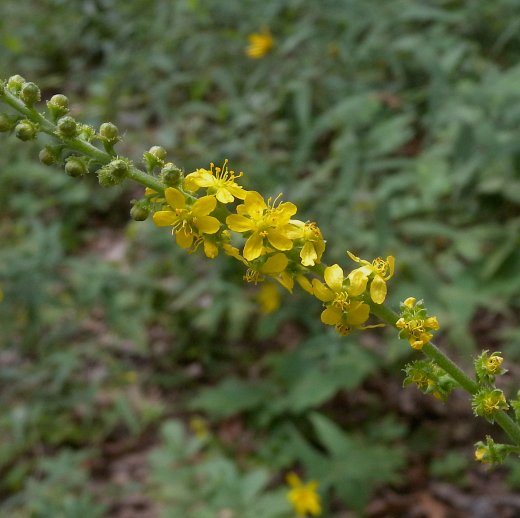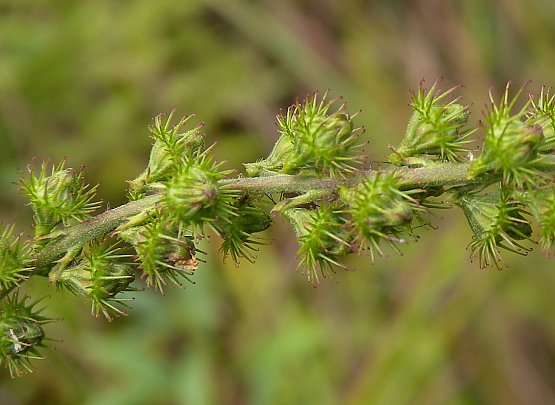Description: This perennial wildflower is 2½–5' tall. The stout central stem is unbranched, terete, and light green, reddish green, or brownish green; it is covered with long hairs that are white or light brown. Along each stem, there are widely spreading alternate leaves. These leaves are odd-pinnate and up to 2' long and ½' across; each leaf has 9-17 primary leaflets and smaller secondary leaflets. The secondary leaflets are located between pairs of primary leaflets. Individual primary leaflets are 2-3" long and about one-third as much across; they are narrowly lanceolate, narrowly oblanceolate, or elliptic with wedge-shaped bottoms and acute tips. Leaflet margins are coarsely dentate. The upper surface of each leaflet is yellowish green and hairless, while the lower surface is short-pubescent. Secondary leaflets are similar to the primary leaflets, but they are much smaller in size (less than 1" long). Both the petiole and rachis of each compound leaf are pubescent; quite often, they have sparse long hairs. At the base of each leaf, there is a pair of large stipules that are fan-shaped and either coarsely dentate or cleft with pointed lobes.

The central stem terminates in a long spike-like raceme about ¾–2½' long. Robust plants also produce secondary racemes from the axils of the upper leaves that are shorter than the terminal raceme. These racemes are usually more or less erect, although longer racemes sometimes bend sideways to become nearly horizontal with the ground. The central stalk of the raceme is light green, terete, and short-pubescent. Numerous small flowers about ¼" across occur along the length of the raceme on short stalks about 1/8" long. Individual flowers consist of a tubular green calyx, 5 yellow petals, about 10 stamens, and a central pistil. The tubular calyx is turbinate in shape and 10-ribbed. The blooming period occurs from mid- to late summer and lasts about 1-2 months. Afterwards, the flowers are replaced by 1-2 seeded fruits about ¼" across. These small fruits have numerous hooked prickles along the upper rims of their persistent calyxes. Immature fruits are green, while mature fruits are brown. The root system is fibrous and rhizomatous. Clonal colonies of plants are often produced.

Cultivation:
Swamp
Agrimony prefers full sun to light shade, moist conditions, and loamy,
silty, gravelly, or sandy soil. It tolerates temporary flooding during
the spring.
Range & Habitat:
Swamp Agrimony is occasional throughout Illinois (see Distribution
Map), where it is native. Habitats include openings in
floodplain woodlands, swamps, soggy
thickets, gravelly seeps, riverbottom prairies and prairie swales, and
roadside ditches. The preceding habitats can be either sandy or
non-sandy.

Faunal Associations: The nectar and pollen of the flowers attract small bees and flower flies (Syrphidae). Larvae of the midge, Contarinia agrimoniae, feed on the flower buds, flowers, & developing seeds of Agrimonia spp. and other species in the Rose family, while an aphid, Macrosiphum agrimoniellum, sucks juices from the flowering stems. Insects that feed on the foliage of Agrimonia spp. include larvae of a sawfly (Fenella nigrita), larvae of a Gelechiid moth (Anacampsis agrimoniella), and larvae of a Tischeriid moth (Coptotriche agrimoniella). Because the foliage is bitter-tasting and high in tannins, it is usually avoided by mammalian herbivores. The bur-like fruits can cling to the fur of mammals, the feathers of birds, and the clothing of humans, which spreads the seeds to new locations.

Photographic
Location:
Near Cowle's Bog at the Indiana Dunes National Lakeshore in NW Indiana,
where it was moist, partially shaded, and sandy.
Comments:
Compared
to other Agrimonia spp. in Illinois, Swamp Agrimony
is
easy to identify because its compound leaves have more primary leaflets
(9-17) and its primary leaflets are more narrow in shape. To a greater
extent than other species in this genus, Swamp Agrimony prefers
habitats that are sunny and wet. Only a few flowers are in
bloom at the same time; they are short-lived and not very showy because
of their small size.